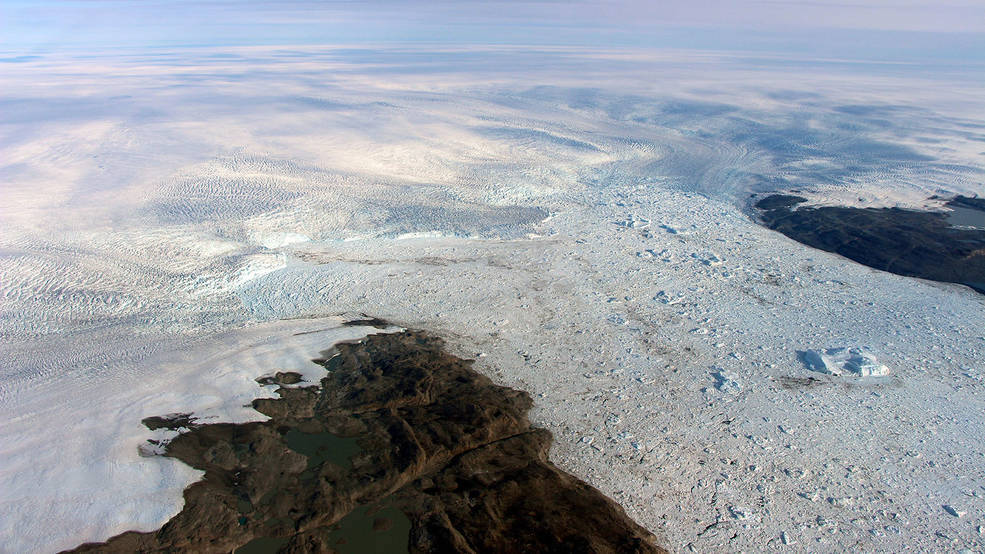Fastest-Thinning Greenland Glacier Threw NASA Scientists for a Loop. It's Actually Growing.
Greenland's fastest-flowing and fastest-thinning glacier recently threw a real brain bender at scientists, who realized that instead of shrinking, the glacier is actually growing thicker, they reported in a new study.
The glacier — known as Jakobshavn, which sits on Greenland's west coast — is still contributing to sea level rise, but it's losing less ice than expected. Instead of thinning and retreating inland, its ice is thickening and advancing toward the ocean, the researchers found.
The big question: Why is this happening? [Images: Greenland's Gorgeous Glaciers]
After much sleuthing, a team of scientists from the United States and the Netherlands found that the glacier is likely growing due to colder ocean currents. In 2016, a current that passes by Jakobshavn Glacier was cooler than usual, making waters near the glacier the coldest they'd been since the mid-1980s.
This cooler current came from the North Atlantic Ocean, more than 600 miles (966 kilometers) south of the glacier, according to data from NASA's Oceans Melting Greenland (OMG) mission and other observations.
The finding took the scientists completely by surprise. "At first, we didn't believe it," study lead researcher Ala Khazendar, a scientist at NASA's Jet Propulsion Laboratory in Pasadena, California, said in a statement. "We had pretty much assumed that Jakobshavn would just keep going on as it had over the last 20 years." But the cold water isn't a one-off. Data from OMG shows that the water has been cold now for three years in a row.
It appears that the cold water is the result of a climate pattern known as the North Atlantic Oscillation (NAO), which makes the northern Atlantic Ocean slowly switch between warm and cold water about once every 20 years, the researchers said. The cold phase just recently started, and has cooled the Atlantic Ocean in general, they said. In addition, some extra cooling of the waters around Greenland's southwest coast helped keep the glacier chilly.
Breaking space news, the latest updates on rocket launches, skywatching events and more!
But this crisp change won't last forever. Once the NAO climate pattern flips back, the Jakobshavn will likely start melting faster and thinning again, the researchers said.
"Jakobshavn is getting a temporary break from this climate pattern," Josh Willis, of the Jet Propulsion Laboratory and the principal investigator of OMG, said in the statement. "But in the long run, the oceans are warming. And seeing the oceans have such a huge impact on the glaciers is bad news for Greenland's ice sheet."
Huge ice loss … then small gain
Scientists have watched Jakobshavn with concern for decades. After losing its ice shelf in the early 2000s (an ice shelf forces a glacier to flow more slowly into the ocean, like dirt clogging a drain), Jakobshavn began losing ice at an alarming rate. Between 2003 and 2016, its thickness (from top to bottom) dwindled by 500 feet (152 meters).

But in 2016, the waters flowing from Greenland's southern tip to its western side cooled by more than 2.7 degrees Fahrenheit (1.5 degrees Celsius). Meanwhile, the NAO climate pattern caused the Atlantic Ocean near Greenland to cool by about 0.5 F (1 C) between 2013 and 2016. By the summer of 2016, these cooler waters reached the glacier, and they are likely the reason that Jakobshavn slowed its rate of ice loss to the ocean, the researchers said. [Image: Greenland's Dramatic Landscape]
In all, Jakobshavn grew about 100 feet (30 m) taller between 2016 and 2017, the researchers found. But, as mentioned, the glacier is still contributing to ocean level rise worldwide, as it's still losing more ice to the ocean than it is gaining from snow accumulation, the researchers said.
The findings shed light on how much ocean temperatures can affect glacier growth, said Tom Wagner, a NASA Headquarters program scientist for the cryosphere, the frozen part of Earth.
"The OMG mission deployed new technologies that allowed us to observe a natural experiment, much as we would do in a laboratory, where variations in ocean temperatures were used to control the flow of a glacier," Wagner, who was not involved in the study, said in the statement. "Their findings — especially about how quickly the ice responds — will be important to projecting sea level rise in both the near and distant future."
The study was published online March 25 in the journal Nature Geoscience.
- Photos: Craters Hidden Beneath the Greenland Ice Sheet
- Photos: Top-Secret, Cold War-Era Military Base in Greenland
- Stunning Photos of Greenland's Supraglacial Lakes
Originally published on Live Science.

Laura is an editor at Live Science. She edits Life's Little Mysteries and reports on general science, including archaeology and animals. Her work has appeared in The New York Times, Scholastic, Popular Science and Spectrum, a site on autism research. She has won multiple awards from the Society of Professional Journalists and the Washington Newspaper Publishers Association for her reporting at a weekly newspaper near Seattle. Laura holds a bachelor's degree in English literature and psychology from Washington University in St. Louis and an advanced certificate in science writing from NYU.


